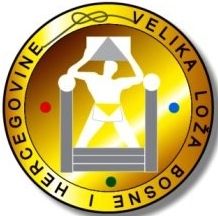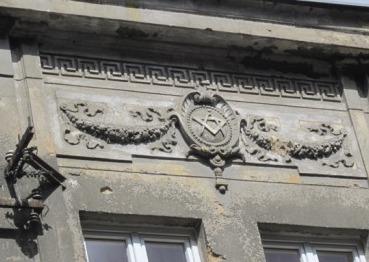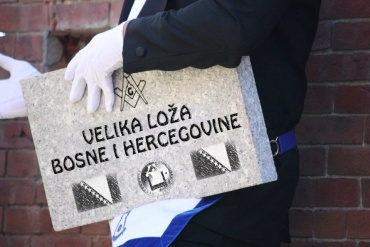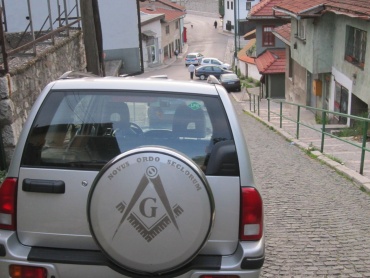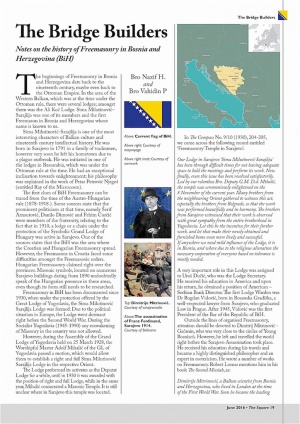Bosnien und Herzegowina
Bosnien und Herzegowina

Strikte ethnische, religiöse und politische Neutralität
Das ist ein Grundsatz, der in der Freimaurerei zwar selbstverständlich sein sollte. Dennoch wird er von der ‚Großloge von Bosnien und Herzegowina’ besonders betont: Wohl aus gutem Grund. Von Rudi Rabe.
Die vier Millionen Einwohner von ‚Bosnien und Herzegowina’ sind eine komplexe Mischung: muslimische Bosniaken, christlich-orthodoxe Serben und katholische Kroaten. Bis 1878 gehörte die Region zum Osmanischen Reich. Dann wurde sie als Folge eines Krieges zwischen diesem Reich und Russland von Österreich-Ungarn übernommen und nach dessen Zerfall 1918 ein Teil des neu gebildeten Jugoslawiens. Abgesehen vom Zweiten Weltkrieg blieb das so bis zur Erklärung der bosnisch-herzegowinischen Unabhängig 1992. Es folgte ein dreijähriger Bürgerkrieg zwischen serbischen, kroatischen und bosniakischen Einheiten, der schließlich 1995 durch internationalen Druck beendet wurde. Seitdem besteht der nach außen souveräne Staat ‚Bosnien und Herzegowina’, der etwas größer als die Schweiz ist, innenpolitisch aus zwei getrennten Entitäten: der ‚Föderation Bosnien und Herzegowina’ (knapp zwei Drittel der Einwohner; vorwiegend Bosniaken und Kroaten) und der Republik Srpska (etwas mehr als ein Drittel; vorwiegend Serben): ein fragiles Gleichgewicht, das unter Aufsicht der UNO steht (2014). Hauptstadt ist Sarajevo.
Aus der masonischen Geschichte
Ab 1878 bildeten sich einige freimaurerische Kränzchen. Zu einem wirklichen Durchbruch kam es aber erst nach 1918, als die Großloge des neuen Staates Jugoslawien zuständig wurde.
In der ottomanischen Epoche gab es einige Logen am Westbalkan, zu dem auch Bosnien und Herzegowina gehören; genaue Aufzeichnungen fehlen aber. Ein Freimaurer, dessen Name bis heute bekannt ist, war Sima Milutinović-Sarajlija von der Loge ‚Ali Koč’, ein Geschäftsmann und Intellektueller im 19 Jahrhundert.
Nachdem das Gebiet 1878 an Österreich-Ungarn ging, entstanden einige freimaurerische Kränzchen, und dann unter der ‚Symbolischen Großloge von Ungarn’ auch Logen. Freimaurerzeichen auf Gebäuden in Sarajewo dokumentieren das.
Zu einem wirklichen Durchbruch kam es aber erst in den Jahren nach 1918, als die Großloge des neuen Staates Jugoslawien zuständig wurde. 1930 wurde in Sarajewo die Loge ‚Sima Milutinović-Sarajlija’ gegründet, knapp vor Beginn des Zweiten Weltkriegs (1939-1945) aber wieder eingeschläfert.
1940 bis 1945: Jugoslawien wird in mehrere Teilstaaten und besetzte Zonen aufgeteilt. Bosnien und Herzegowina werden zum faschistischen Ustascha-Kroatien geschlagen: masonische Dunkelheit.
1945 bis zum Zerfall Jugoslawiens: Weiter Verbot des Freimaurerei, jetzt durch die Kommunisten.
1999 wird ein neuer Grundstein gelegt
Nach Ende des dreijährigen Bürgerkriegs knüpften österreichische Freimaurer erste Kontakte. Und 1999 errichtete die ‚Großloge von Österreich’ unterstützt von der ebenfalls mit österreichischer Hilfe kurz zuvor gegründeten ’Großloge von Slowenien’ in der Hauptstadt Sarajevo die Deputationsloge ‚Lux Bosniae’.
2004/2005: Die beiden Großlogen halfen bei der Gründung weiterer Deputationslogen. Es entstehen die ‚Ivo Andric’ und die ‚Veritas’. Und so können die Österreicher und die Slowenen im April 2005 das Licht in die ‚Großloge von Bosnien und Herzegowina’ (Velika Loža Bosne i Hercegovine) einbringen.
Die Freimaurer aus der Hauptstadt Sarajewo legen Wert auf die Feststellung, dass an dieser Entwicklung auch Brüder aus Banja Luka, Tuzla, Bihac und Mostar beteiligt waren. Trotz der langen Fahrzeiten kamen sie regelmäßig nach Sarajewo.
2014: 15 Jahre werden gefeiert
Das Fest wurde international zur Kenntnis genommen: Anwesend waren Delegationen aus der Türkei, aus Österreich, Bulgarien, Montenegro, Serbien, Kroatien, Slowenien, Belgien und zwei Brüder aus Deutschland. Eindruck: Die Großloge entwickelt sich gut. Es gibt jetzt fünf Logen, die Mitgliederzahl nimmt zu; viele junge engagierte Brüder. Die Festarbeit konnte in einem neuen Logenhaus stattfinden, das mit Hilfe dreier Brüder und besonders unterstützt von der türkischen Großloge oberhalb von Sarajewo errichtet worden war.
2014 gab es in Bosnien und Herzegowina in drei Logen ungefähr 200 Freimaurer.
The Bridge Builders
Unter diesem Titel brachte das englische Freimaurer-Magazin The Square im Juni 2016 einen zweiseitigen Artikel über Geschichte und Gegenwart der Freimaurerei in Bosnien und Herzegowina. Darin wurde auch die österreichische Hilfe beim Aufbau ab den 1990iger Jahren gewürdigt. Mit Erlaubnis von ‘The Square’ geben wir den Artikel hier wieder.
The Bridge Builders
Notes on the history of Freemasonry in Bosnia and Herzegovina (BiH)
Brother Nazif H. and Brother Vahidin P.
The beginnings of Freemasonry in Bosnia and Herzegovina date back to the 19th century, maybe even back to the Ottoman Empire. In the area of the Western Balkan which was at the time under the Ottoman rule, there were several Lodges; amongst them was the Ali Koč Lodge. Sima Milutinović–Sarajlija was one of its members and the first Freemason in Bosnia and Herzegovina whose name is known to us.
Sima Milutinović-Sarajlija is one of the most interesting characters of Balkan culture and 19th century intellectual history. He was born in Sarajevo in 1791 in a family of tradesmen, however very soon he left his home town due to a plague outbreak. He was initiated in one of the lodges in Bessarabia which was under the Ottoman rule at the time. He had an exceptional inclination towards enlightenment; his philosophy was explained in the work of Petar Petrović Njegoš (entitled Ray of the Microcosm).
The first clues of BiH Freemasonry can be traced from the time of the Austro-Hungarian rule (1878-1918.). Some sources state that the prominent politicians at that time, namely Šerif Arnautović, Danilo Dimović and Fehim Čurčić were members of the fraternity, relating to the fact that in 1910, a lodge or a chain under the protection of The Symbolic Grand Lodge of Hungary was active in Sarajevo.
One of the sources states that the BiH was the area where the Croatian and Hungarian Freemasonry spread: However, the Freemasons in Croatia faced some difficulties amongst the Freemasonic orders. Hungarian Freemasonry claimed right over the provinces.
Masonic symbols, located on numerous Sarajevo buildings dating from 1890 undoubtedly speak of the Hungarian presence in these areas, even though its form still needs to be researched.
Freemasonry in BiH has been documented since 1930, when under the protection offered by the Great Lodge of Yugoslavia, the Sima Milutinović Sarajlija Lodge was formed. Due to the political situation in Europe, the Lodge went dormant right before the Second World War; During the Socialist Yugoslavia (1945-1990) any reawakening of Masonry in the country was not allowed.
However, during the Assembly of the Grand Lodge of Yugoslavia held on 25 March 1928, the Worshipful Master Adolf Mihalić of the GL of Yugoslavia passed a motion which would allow them to establish a right and full Sima Milutinović Sarajlija Lodge in the respective Orient.
The Lodge preformed its activates as the Deputat Lodge for a while, until in 1930 it was awarded with the position of right and full Lodge, while in the same year, Mihalić consecrated a Masonic Temple . It is still unclear where in Sarajevo this temple was located. In The Compass No. 9/10 (1930), 204-205., we come across the following record entitled “Freemasonry Temple in Sarajevo“
Our Lodge in Sarajevo “Sima Milutinović Sarajlija“ has been through difficult times for not having adequate space to hold the meetings and perform its work. Now finally, even this issue has been resolved satisfactorily. Led by our relentless Brother Deputy Grandmaster D. d. Mihalić, the temple was ceremoniously enlightened on the 8 November of the current year. Many brothers from the neighbouring Orient gathered to witness this act, especially the brothers from Belgrade, so that the work was performed beautifully and in harmony. The brothers from Sarajevo witnessed that their work is observed with great sympathy from the entire brotherhood in Yugoslavia. Let this be the incentive for their further work, and let that make their newly obtained and furnished home even more lively and successful. If anywhere we need mild influence of the Lodge, it is in Bosnia, and where due to the religious alienation the necessary cooperation of everyone based on tolerance is mostly needed.
A very important role in this Lodge was assigned to Uroš Dučić, who was the Lodge Secretary. He received his education in America and upon his return he obtained a position of American – Serbian Bank Director. The first Lodge Warden was Dr. Bogdan Vidović, born in Bosanska Gradiška, a well-respected lawyer from Sarajevo, who graduated Law in Prague. After 1945, Vidović was the first President of the Bar of the Republic of BiH.
Outside the lines of organised Freemasonry, attention should be devoted to Dimitrij Mitrinović-Gačanin, who was very close to the circles of Young Bosnian’s. But he left and travelled the world right before the Sarajevo Assassination took place. He received his education during his travels and became a highly distinguished philosopher and an expert in esotericism. He wrote a number of works on Freemasonry. Robert Lomas mentions him in his book Second Messiah as:
“Dimitrije Mitrinović, a Balkan scientist from Bosnia and Herzegovina, who lived in London at the time of the First World War. Soon he became the leading individual in the Bloomsbury Group, gathering only English intellectuals. The name of the group was chosen as such, because most of the members lived in the area of the same name in the centre of London, near the British Museum. Its members were well-respected thinkers of the age in the field of art and social sciences. Amongst its members were Virginia Woolf and her husband Leonard, economist John Maynard Keynes, and a writer and an essayist E. M. Forster. “
According to Lomas, this scientist from Bosnia and Herzegovina was one of the significant Masonic thinkers. His records written in our language still exist, but most of his work was written in English. That is the heritage which has yet to be discovered.
Nearly seventy years after WWII, Freemasonry in BiH began its revival. Under the patronage of the Great Lodge of Austria and Slovenia, considerable efforts were put forth in re-establishing Freemasonry in BiH. Freemasonry in BiH is greatly indebted to this support. Without their help, the spreading of light of the fraternity and humanity would not be possible in Bosnia and Herzegovina. Special appreciation was expressed to honourable brother Günther Hödl, who was at the time a Grand Master Assistant and a Representative of the Grand Lodge of Austria. He coordinated the activities related to restoring Freemasonry in Bosnia and Herzegovina. For this reason Bosnian-Herzegovinian Masons share a special connection with the Austrian and Slovenian brothers.
The first reception was held in Sarajevo in 2001. At the same time, the oldest of the brethren invested their best efforts to ensure that Bosnian-Herzegovinian Masonry is provided with “ a roof over their heads“, i.e. permanent temple. This task was accomplished in November in 2004, and the dedicated temple was opened in Sarajevo. This improved the conditions to performing undisturbed work on the rough and unpolished stone. Special efforts were undertaken by our brothers from Banja Luka, Tuzla, Bihac and Mostar who in spite of the distance regularly come to Sarajevo. Ever more likely, we ought to respect the efforts of our elder brothers who have travelled to Slovenia in order to revive and maintain Freemasonry, until the conditions in Sarajevo temple and other temples in Bosnia and Herzegovina were made acceptable for the performance of regular rituals.
The setting up of three lodges operated under the Great Lodge of Austria, met the conditions to form a Grand Lodge of Bosnia and Herzegovina. The most complex and glorious ritual in Sarajevo in April 2005, was led by H. Brother Günther Hödl, and attended by a great number of Bosnian-Herzegovinian, Austrian and Slovenian Freemasons, as well as the representatives of all great European Lodges, thus the light was brought to the GL BiH, formally declaring BiH as independent. The first Grand Master of GL BiH was appointed, the most Honourable Brother E. D.
E. D., born in Brčko, a well-respected doctor and an expert in sport medicine, the first Master of the Grand Lodge in BiH (2005-2010.), contributed greatly in restoring Freemasonry in Bosnia and Herzegovina. He led intensive negotiations with the Austrian and Slovenian brothers and found the first four Bosnian brothers from different parts of the world. Investing a great energy in setting the foundations, promoting and empowering Freemasonry in BiH, he fought for its world recognition. He set the foundations for what is the current structure of Bosnian-Herzegovinian Masonry, including the establishment of the Side Orders. He is still very active, constantly contributing to the growth of the brotherhood.
Freemasonry in Bosnia and Herzegovina currently (September 2014.) accounts for 200 members. GL BiH has been recognised by all the relevant Free Masonry institutions in regular Masonry, amongst them the UGLE, England Mother Lodge.
Currently it holds the status of one of the full members of the global fraternal chain. In this context, our Grand Master of Grand Lodge of BiH, I. R., gives special attention and dedication in nurturing the fraternal relations with the Lodges in Austria, Slovenia, Croatia, Serbia, Montenegro, Italy and many other countries. Fraternal relations have been established with the Turkish, Croatia and Serbia Grand Lodges, while planning to establish closer connections with the German, Slovenia and Austria lodges, which accepted our brothers from Bosnia and Herzegovina back in the 1920’s.
For sure, one of the peaks of Freemasonry in BiH was the foundation of Research Lodge Quatuor Coronati No.7, Orient Sarajevo, where after long preparation light was brought on 3 October 6015. The first elected Worshipful Master was Brother N. H. from BiH while other equal members and Officers were Brethren from eight different countries, giving this Lodge significant international dimension. RL QC No.7 will in forthcoming period dedicate its efforts to research and study freemason history in BiH and Europe, as well as its ritualistic and intercultural role. The goal of RL QC No.7 will be to raise the freemason awareness, thus generating new discourse on freemasonry within the brotherhood as well as in the outer world. Preparations are underway to prepare for the publishing of the RL QC No.7 annual magazine followed by other editions as well.
The history of Freemasonry in Bosnia and Herzegovina has been characterised by good and bad times, transitions from one political system or a civilisation to another. What can be concluded from these notes is that there are some unbreakable bonds between the history of Freemasonry in BiH and the course of Freemasonry in Balkan and Central Europe. In a certain way it speaks of the unbreakable connection of our three countries, despite the political and other separations. Our task can be described by the quote of Mehmed Paša-Sokolović from Ivo Andrić’s book “The Bridge on the Drina river” - build bridges which would connect coasts, cities, cultures and peoples. These bridges will last longer than any borders which can be found within and around us.
Ergänzung der Wiki-Redaktion: Der im Artikel erwähnte Günther Hödl war Historiker und mehrmals Rektor der Universität Klagenfurt. In der Zeit der von ihm im April 2005 in Sarajewo geleiteten Freimaurerarbeit wurde bei ihm Lungenkrebs diagnostiziert. Er starb im August im Alter von 64.
Siehe auch
- Sarajevo
- Slowenien
- Kroatien
- Serbien
- Montenegro
- Mazedonien
- Kosovo
- Jugoslawien (1918 bis 1991)
- Albanien
- Österreich
- The Square: das englische Magazin.
Links
- Ein bosnischer Fernsehbericht über die Freimaurerei https://www.youtube.com/watch?v=qTIiAyoH7g0

